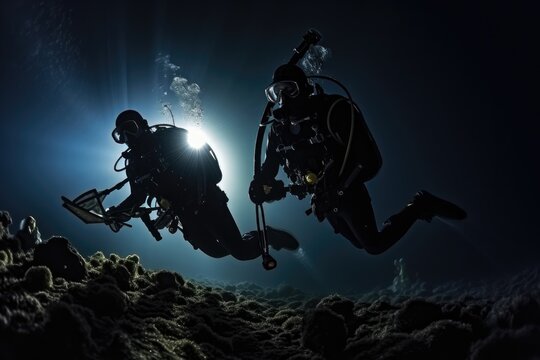12 Unique Marine Creatures You Can Encounter as a Night Diver

Strong 8k brings an ultra-HD IPTV experience to your living room and your pocket.
Night diving is a thrilling and unique experience that allows divers to explore the underwater world after dark. As the sun sets, the ocean undergoes a dramatic transformation, and many marine creatures that remain hidden during the day come out to play. As a night diver, you can encounter an array of fascinating and unique marine life that you would rarely see during daylight dives. Here are 12 unique marine creatures you can encounter as a night diver.
1. Octopus
Octopuses are elusive and intelligent creatures that are often more active and visible at night. They are known for their remarkable ability to change color and texture to blend into their surroundings, making them masters of camouflage. During night dives, you might spot an octopus hunting for prey or moving across the ocean floor in search of a new hiding spot.
Characteristics:
Highly intelligent and curious
Excellent camouflage abilities
Typically found in rocky crevices or coral reefs
Active hunters at night
2. Nudibranchs
Nudibranchs, also known as sea slugs, are colorful and intriguing creatures that come in a wide variety of shapes and sizes. These slow-moving mollusks are often more visible during night dives when their vibrant colors stand out against the dark backdrop of the ocean. Nudibranchs are known for their striking patterns and hues, which can be a delight for night divers to observe.
Characteristics:
Brightly colored with unique patterns
Slow-moving and easy to photograph
Found on coral reefs, rocks, and sandy bottoms
Often feed on sponges and other small invertebrates
3. Moray Eels
Moray eels are nocturnal predators that are typically more active at night. These long, slender fish are known for their menacing appearance and sharp teeth. During a night dive, you might see moray eels emerging from their daytime hiding spots in search of food. They can often be found peeking out from crevices or holes in the reef.
Characteristics:
Long, snake-like bodies
Sharp teeth and strong jaws
Nocturnal hunters
Often found in crevices or holes in the reef
4. Basket Stars
Basket stars are a type of brittle star that are rarely seen during the day but become more visible at night. These fascinating creatures have long, branching arms that they use to capture plankton and other small particles from the water. Basket stars are usually found attached to coral or rocks, and their intricate, lace-like arms make them a captivating sight for night divers.
Characteristics:
Long, branching arms
Feed on plankton and small particles
Found attached to coral or rocks
More active and visible at night
5. Spanish Dancer
The Spanish dancer is a type of large nudibranch known for its striking red coloration and graceful, undulating movements. This sea slug gets its name from its resemblance to a flamenco dancer's flowing dress. During night dives, Spanish dancers are more likely to be seen swimming in the open water, providing a mesmerizing display of their vibrant beauty.
Characteristics:
Bright red coloration
Graceful, undulating swimming movements
Found in coral reefs and rocky areas
More likely to be seen swimming at night
6. Lionfish
Lionfish are known for their striking appearance, with long, venomous spines and bold stripes. These fish are more active hunters at night, making them easier to spot during a night dive. Despite their beautiful appearance, lionfish are invasive in some areas and pose a threat to local marine ecosystems. As a night diver, you can observe their hunting behavior and appreciate their unique beauty.
Characteristics:
Long, venomous spines
Bold stripes and striking appearance
Active hunters at night
Found in coral reefs and rocky areas
7. Bobtail Squid
Bobtail squids are small, nocturnal cephalopods that are rarely seen during the day. These tiny creatures have the ability to produce light through bioluminescence, which they use to camouflage themselves from predators. During night dives, bobtail squids can often be seen hovering near the sand or hiding in the seafloor. Their bioluminescent displays are a true highlight of night diving.
Characteristics:
Small, nocturnal cephalopods
Bioluminescent abilities
Often found near the sand or hiding in the seafloor
Use light to camouflage from predators
8. Parrotfish
Parrotfish are known for their vibrant colors and beak-like mouths, which they use to scrape algae off coral. While they are commonly seen during the day, parrotfish exhibit a unique behavior at night: they create a mucus cocoon to sleep in. This cocoon helps protect them from predators and parasites. Observing parrotfish in their nighttime cocoons is a fascinating sight for night divers.
Characteristics:
Vibrant colors and beak-like mouths
Feed on algae and coral
Create mucus cocoons to sleep in at night
Found in coral reefs and rocky areas
9. Crabs and Lobsters
Many species of crabs and lobsters are nocturnal and are more likely to be seen during night dives. These crustaceans emerge from their daytime hiding spots to scavenge for food under the cover of darkness. Night divers can observe a variety of crab and lobster species, from the tiny porcelain crab to the larger spiny lobster, each with its unique behaviors and characteristics.
Characteristics:
Nocturnal scavengers
Various species with unique behaviors
Found in coral reefs, rocky areas, and sandy bottoms
Active and visible at night
10. Bioluminescent Plankton
One of the most magical experiences of night diving is encountering bioluminescent plankton. These tiny organisms emit light when disturbed, creating a mesmerizing display of underwater "fireworks." As you move through the water, the bioluminescent plankton light up, creating a trail of glowing particles that illuminate the dark ocean. This natural phenomenon is a highlight of night diving and offers a truly otherworldly experience.
Characteristics:
Tiny, bioluminescent organisms
Emit light when disturbed
Create glowing trails in the water
Found in various marine environments
11. Stingrays
Stingrays are often more active and easier to spot during night dives. These graceful creatures glide along the ocean floor in search of food, such as small fish and crustaceans. Night divers can observe stingrays' unique hunting techniques and their impressive ability to blend into their surroundings. The sight of a stingray gracefully moving through the water is a memorable experience for any night diver.
Characteristics:
Graceful, flat-bodied fish
Nocturnal hunters
Feed on small fish and crustaceans
Often found on sandy bottoms and near coral reefs
12. Sea Turtles
Sea turtles are majestic creatures that can occasionally be encountered during night dives. While they are typically more active during the day, some sea turtles continue to forage for food or rest in the reef at night. Spotting a sea turtle during a night dive is a special experience, offering a glimpse into the nocturnal behaviors of these ancient marine reptiles.
Characteristics:
Majestic, slow-moving reptiles
Forage for food or rest in the reef at night
Found in coral reefs, seagrass beds, and rocky areas
Occasionally encountered during night dives
Conclusion
Night diving offers a unique and exhilarating opportunity to explore the underwater world in a completely different light. The ocean comes alive with a variety of fascinating and unique marine creatures that are rarely seen during the day. From the elusive octopus and vibrant nudibranchs to the mesmerizing bioluminescent plankton and majestic sea turtles, night diving allows you to encounter a diverse array of marine life.
Enrolling in night diving courses or guided night dives can enhance your diving skills and open up a whole new realm of underwater exploration. So, gear up and take the plunge into the dark depths – the ocean's nocturnal wonders await you.
Note: IndiBlogHub features both user-submitted and editorial content. We do not verify third-party contributions. Read our Disclaimer and Privacy Policyfor details.


